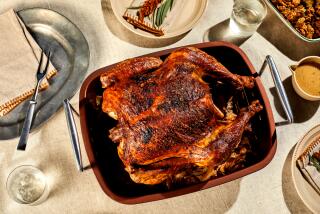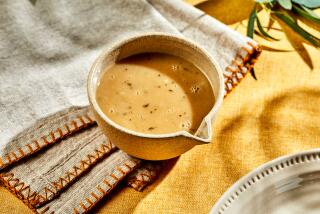The art of carving
- Share via
A beautiful turkey is not just about cooking. There’s carving too. Judy Rodgers has very specific ideas about how this should be done.
Transfer the turkey from the roasting pan onto a platter. Slice through the skin between the leg and the breast, and begin folding back the leg, rolling the turkey on its side. Fold the back leg farther to expose the ball joint at the hip. Use the tip of a boning knife to free the leg. Cut the leg in two at the knee joint, leaving a drumstick and a thigh.
“I don’t aim for pretty slices from the drumstick,” Rodgers says. “It’s too full of ‘hatpin’ bones. I just carve off the meat in three or four neat chunks, sliding the knife against the bone and rotating the bone with each slice.”
To carve the thigh, set it skin-side up on the cutting board and slice parallel to the bone, on either side of it.
To carve the breast meat, use a boning knife to remove the whole breast, as though you were boning a chicken breast. Slide the tip of the knife close along the sternum and then gradually pry the whole breast away, using a series of little cuts, holding the blade of the knife flat against the sternum and rib cage. (If the turkey has rested properly, it won’t be too hot to handle.) Use the tip of the knife to sever the tenacious sinews at the base of the wing.
Study the direction of the fibers on the boned side of the breast — they curve abruptly near the wing joint but generally run in a slight arc the length of the muscle. Now place the breast flat on the cutting board and carve nearly straight down across the grain into inch-thick slices.
This will produce slices that are as tender as possible. Wide slices cut on a steep angle may look elegant or impressive, but will be tougher, because they leave too much muscle fiber intact.
More to Read
Eat your way across L.A.
Get our weekly Tasting Notes newsletter for reviews, news and more.
You may occasionally receive promotional content from the Los Angeles Times.










